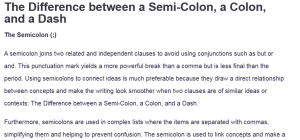The Difference between a Semi-Colon, a Colon, and a Dash
The Semicolon (;)
A semicolon joins two related and independent clauses to avoid using conjunctions such as but or and. This punctuation mark yields a more powerful break than a comma but is less final than the period. Using semicolons to connect ideas is much preferable because they draw a direct relationship between concepts and make the writing look smoother when two clauses are of similar ideas or contexts: The Difference between a Semi-Colon, a Colon, and a Dash.
Furthermore, semicolons are used in complex lists where the items are separated with commas, simplifying them and helping to prevent confusion. The semicolon is used to link concepts and make a distinction between them without fully separating them, which can enhance the clarity and flow of the writing.
For instance, in the sentence, “I enjoy hiking; it’s my favorite way to relax,” the semicolon unites two related independent clauses. The first clause, “I enjoy hiking,” is linked to the second clause, “It’s my favorite way to relax,” and the semicolon highlights that both thoughts interlink. A semicolon preserves a gap without making the two conjoined concepts look as distant as when separated by a period. It is also useful to prevent the reader’s confusion because it connects two thoughts while keeping the inclination of the sentence.
The Colon (:)
A colon introduces information that explains, elaborates, or provides a list related to the preceding clause. Before the colon, there must be an independent clause, and the users need to use a colon and know there will be more information coming next (Camp & Satterwhite, 2019). Colons are used to put an emphasis or describe something relevant to the initial statement.
They can be applied to call attention to an example, an explanation, or even a quote. The colon makes sense in that it connects a general idea to specific information and makes certain that the information following it is related to the thoughts initially expressed.
For example, in the sentence, “She brought all the essentials for camping: a tent, sleeping bags, and a first aid box,” the colon provides the list of what it means by all the essentials for camping. The first part of the sentence represents a complete clause; thus, it makes sense to use the colon to introduce the details of things listed in the second part of the sentence. In this case, the colon alerts the reader to more information, a list that will expound on the general idea given. This makes the sentence clearer and more specific about the items required for camping.
The Dash (—)
A dash is a punctuation mark employed to draw attention in writing besides indicating a sudden change or new notion or providing an impressive pause in a sentence. In some contexts, it can even substitute a comma, parentheses, or even a colon, depending on the context. Dashes are employed to show the pause in thought or bring a more informal, conversational tone to the context. They are most commonly used for providing contrast after what is said is not necessary for understanding or after an element of surprise that changes the direction of the sentence is needed.
For instance, in the sentence, “He loved everything about her—her laugh, her wit, and her adventurous spirit,” the dash sets the tone to emphasize the characteristics that make her special. It provides a pause that shifts focus on the list after it, making the entire sentence much more dynamic and impactful. The dash is more striking than a comma would be because the qualities that are being enumerated are important. By using the dash, the writer introduces a slight interruption in the flow of the sentence but, at the same time, enforces intensity in the drama, emphasizing the speaker’s admiration.
References
Camp, S. C., & Satterwhite, M. L. (2019). College English and business communication (11th ed.). McGraw Hill Education
ORDER A PLAGIARISM-FREE PAPER HERE
We’ll write everything from scratch
Question
- What is the difference between a semi colon, a colon, and a dash.Write an original sentence with the correct use of each
The Difference between a Semi-Colon, a Colon, and a Dash


